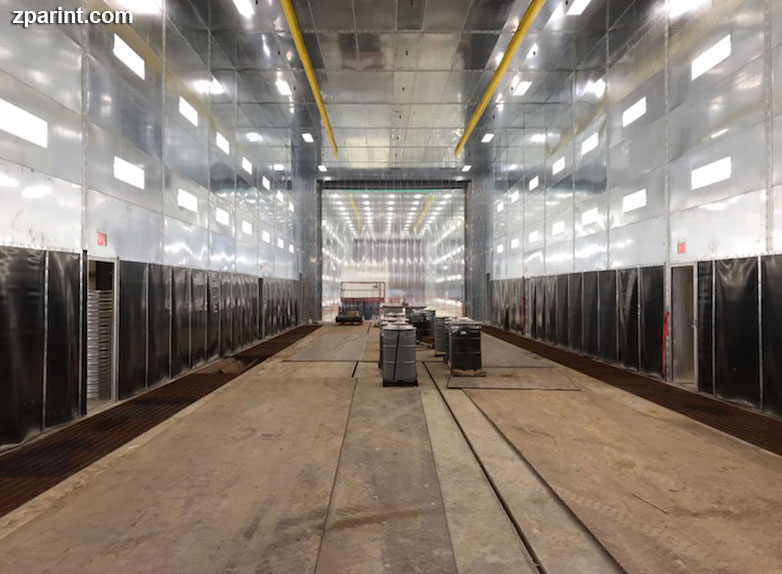Abrasive blasting is a process done in order to prepare a surface or achieve the desired profile for a specific surface and purpose. The surface is then finished off with a coat of wet or powder paint to create a protective layer over the surface and prevent it from getting exposed to external elements. It is a dangerous and risky process and proper equipment and industrial finishing systems with safety precautions must be used in order to prevent any accident.
Abrasive Blasting and Its Uses
 The process of abrasive blasting makes use of a compressed and high-pressure stream of air or water to project an abrasive material onto the object surface to achieve a specific purpose. This can be the cleaning off the surface from contamination, corrosion, or coating, creating a specific profile or texture on the surface, or smoothing the surface.
The process of abrasive blasting makes use of a compressed and high-pressure stream of air or water to project an abrasive material onto the object surface to achieve a specific purpose. This can be the cleaning off the surface from contamination, corrosion, or coating, creating a specific profile or texture on the surface, or smoothing the surface.
Depending on the pressure and the type of abrasive media used, the surface undergoing blasting will have a smooth, textured, angled, or dented profile. There is a wide variety of abrasive media ranging in different sizes, density, hardness, and shape and their selection depends on the surface profile required and the type of abrasive blasting being used.
Abrasive blasting has a wide usage on a commercial and industrial level. Abrasive blasting, also known as grit or sandblasting, can be used to:
- Smooth out a surface
- Clean a surface for further action
- Create a certain texture on to an otherwise smooth surface
- Eradicate contamination, residues, and rust from a surface
- Prepare a specific surface profile
Abrasive Blasting Process
The selected abrasive media is accelerated at high pressure through a blast nozzle onto the object’s surface. The abrasive media can be propelled by means of compressed water or air depending on the abrasive media and the surface.
The blasting system can be:
- Slurry blasting system
- Siphon system
- Direct pressure system
Slurry blasting systems make use of pressurized water to blast the abrasive material on the surface. The slurry can be used again and again. The siphon system makes use of compressed air to pull out the media from a hopper and project it onto the blasting surface. The direct pressure system uses a pressure pot and a blast hose to propel the abrasive media on the surface. The direct pressure system is more efficient and therefore more widely used.
For a more precise and fine profile, wet or dustless blasting is used. A paint booth or a spray booth may be placed in the near vicinity to transfer the blasted surface into the spray booth or the paint booth for further action.
What is an Abrasive Blast Booth?
 Abrasive blast booths are required for ensuring a safe abrasive blasting process. Abrasive blasting can be hazardous for the health of the operational personnel and also can create a risk of fire or electric shock. Using a proper abrasive blasting booth can ensure a safe blasting process. These blasting booths are used to prepare the surface which is then transferred to the spray booth or paint booth.
Abrasive blast booths are required for ensuring a safe abrasive blasting process. Abrasive blasting can be hazardous for the health of the operational personnel and also can create a risk of fire or electric shock. Using a proper abrasive blasting booth can ensure a safe blasting process. These blasting booths are used to prepare the surface which is then transferred to the spray booth or paint booth.
Abrasive blast booths are usually a simple nut and bolt assembly so that they can be assembled easily and quickly. Abrasive blast booths are usually expensive to build but by using different gauges of steel, an efficient abrasive blast booth can be achieved at a considerably economical value. Abrasive blast booths can be of various sizes and dimensions depending on the use and application.
Advanced abrasive blast booths will not only prepare the surface but are included with some additional features. The additional features include dust collection and reclaim systems. The add-ons on the abrasive blast booth help to make this process more efficient, safe, make the booth more durable and long-lasting and improve working conditions.
What are the Different Types of Abrasive Blasting?
 There are several different types of abrasive blasting depending on the media being used, the purpose of blasting, and the method being used. Some of the types include:
There are several different types of abrasive blasting depending on the media being used, the purpose of blasting, and the method being used. Some of the types include:
- Shot Blasting: this blasting is usually done on metals and uses spherical steel shots as the abrasive media. This type of blasting cleans the surface and increases the compressive strength of the surface.
- Wet Blasting: it makes use of pressurized water along with an abrasive media to achieve the desired profile. It is dust-free blasting and is therefore preferred for fine profiling of the surface.
- Dry-Ice Blasting: this blasting is mainly used in the food industry to clean out food processing equipment. The blasting process makes use of pressurized air and small pellets of dry ice (carbon dioxide) to clean the blasted surface.
- Bead Blasting: this type of blasting makes use of glass beads as an abrasive media. The beads can be wet or dry blasted at a low pressure to achieve a clean and bright surface which may be slightly textured. It is effective for getting rid of rust, sand, scale or paint.
- Micro-Blasting: this is mainly used for blasting of small surfaces. Glass etching is one of the major applications; it is also preferred for detailed and precise applications.
Conclusion
Many industries including automotive, marine, aerospace, etc. require a proper setup for abrasive blasting. Quite a number of industrial finishing systems for abrasive blasting are being prepared to meet rigorous requirements. Abrasive blasting enclosures are a must for the above mentioned industries to ensure effectiveness as well as safety for everyone. Give us a call today and we’ll find an abrasive blasting solution to fit your needs!

